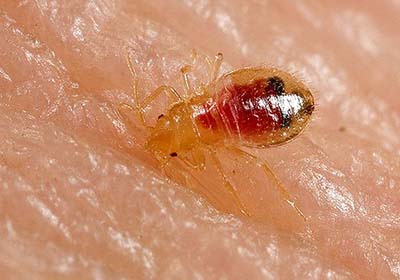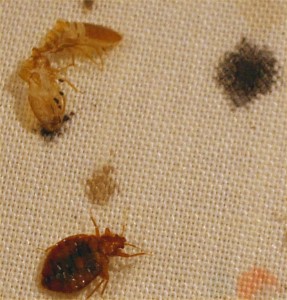Bed bugs are transferred during relocation through infested furniture, clothing, and bedding. They can also hide in luggage or boxes.
Relocating to a new home can be an exciting adventure, but it also comes with its challenges. One of the most unwanted challenges is the potential transfer of bed bugs during the move. These tiny pests can easily hitch a ride on your furniture, clothing, or bedding, causing a full-blown infestation at your new place.
Therefore, it’s essential to take precautionary measures to prevent the spread of bed bugs during the relocation process. We’ll explore how bed bugs are transferred during relocation and provide practical tips to minimize the risk of bringing these unwanted critters into your new home.
Understanding Bed Bugs
Bed bugs are small, reddish-brown insects that feed on the blood of humans and animals. They are nocturnal creatures that hide in cracks and crevices during the day and come out at night to feed on their hosts.
Appearance And Behavior Of Bed Bugs
Bed bugs are oval-shaped and about the size of an apple seed, making them difficult to detect. They can move quickly over floors, walls, and ceilings, and are expert hitchhikers, often latching onto clothing or luggage for transportation.
Notorious Reputation Of Bed Bugs
Bed bugs have gained a notorious reputation due to their ability to infest homes and spread rapidly. Their resilience to many pesticides and their secretive nature make them a challenging pest to eradicate.

Credit: mattresssafe.com
Transferring Bed Bugs
Transferring Bed Bugs:
Common Means Of Transferring Bed Bugs
When traveling to a new location, you may unknowingly carry
bed bugs in your belongings.
- Bed bugs can hitch a ride on luggage, clothing, or furniture.
- They also transfer through second-hand items or public transportation.
- Vigilance is crucial to prevent these pests from spreading.
Possible Sources Of Bed Bug Infestations During Relocation
It’s important to identify potential sources of bed bugs during relocation.
- Shared moving trucks and storage units can harbor bed bugs.
- Used furniture or mattresses might already be infested.
- Inspecting items before moving can help avoid infestations.
Hiding Spots And Hitchhiking
During the chaos and confusion of relocation, the last thing anyone wants to think about is bed bugs. These pesky hitchhikers can easily find new hiding spots and latch onto unsuspecting belongings, making moving day a potential nightmare. Understanding where bed bugs hide and how they hitchhike is crucial in preventing their spread during the relocation process.
Where Bed Bugs Hide During Relocation
Bed bugs are notorious for their ability to hide in cracks and crevices, making them incredibly difficult to spot. When it comes to relocation, these pests are experts at finding new hiding spots within your belongings. Here are a few common places where bed bugs hide during the relocation process:
- Bed frames and headboards: Bed bugs often seek refuge in the seams, cracks, and joints of bed frames and headboards.
- Mattresses and box springs: Due to their flat shape, mattresses and box springs provide the perfect hiding spots for bed bugs.
- Upholstered furniture: Couches, chairs, and other upholstered furniture give bed bugs ample hiding places in the seams and cushions.
- Electronics and appliances: Bed bugs can crawl into electronics and appliances, making them challenging to detect.
- Clothing and luggage: Fabric items, especially clothing and luggage, can become infested with bed bugs, giving them an easy way to travel.
How Bed Bugs Hitchhike During Relocation
Bed bugs are master hitchhikers, eagerly latching onto items as they move from one location to another. By understanding how they hitchhike, you can take necessary precautions to prevent their spread during relocation:
- Belongings: As you pack your belongings, bed bugs can crawl into boxes, bags, or other containers, hoping for a free ride.
- Furniture: Infested furniture, such as mattresses or couches, can transport bed bugs from one place to another.
- Public transportation: Bed bugs may cling to your clothing or belongings while using public transportation, such as buses, trains, or taxis.
- Hotels and motels: If you stay in an infested hotel or motel during the relocation, bed bugs can hide in your luggage and accompany you back home.
- Neighbors: If you live in an apartment building or have close neighbors, bed bugs can easily travel through walls or crawl across shared spaces.
| Precautions to Take Against Bed Bugs During Relocation |
|---|
| • Inspect all items for signs of bed bugs before packing. |
| • Seal infested items in plastic bags to prevent bed bugs from spreading. |
| • Launder clothing and linens at a high temperature to kill any potential bed bugs. |
| • Use protective covers for mattresses and box springs. |
| • Keep personal items separate from public spaces during transportation. |
Preventing Bed Bug Transfer
When relocating, it’s important to take measures to prevent the transfer of bed bugs to your new home. This pesky pest can easily hitch a ride on your furniture and belongings, leading to an infestation in your new space. By being mindful and proactive, you can minimize the risk of bed bug transfer and protect your new environment.
Inspecting Furniture And Belongings
Before moving, thoroughly inspect all furniture and belongings for any signs of bed bugs. Look for small, rust-colored stains, shed skins, or actual bugs in the seams, cracks, and crevices. Consider discarding any heavily infested items that are difficult to treat effectively.
Preparing For Relocation With Bed Bug Prevention In Mind
Prior to packing, carefully clean and inspect all items. Use sealed plastic bags or containers to store loose articles, and double-check that all openings are tightly sealed. Consider consulting with a pest control professional to treat larger items or high-risk furniture, such as mattresses and upholstered pieces.
Treatment And Elimination
Treatment and Elimination of Bed Bugs During Relocation
Bed bugs are notorious for hitchhiking during relocations, making it crucial to address treatment and elimination methods to prevent an infestation in your new home. Understanding how to identify an infestation, hiring professionals for effective treatment, and utilizing DIY methods for eradication are essential for a smooth transition without bed bug concerns.
Identifying A Bed Bug Infestation
Identification of a bed bug infestation is key to prompt action. Look for red, itchy welts on the skin, bloodstains on sheets, or musty odors in the new environment. Additionally, inspect the mattress seams, bed frame, and nearby furniture for small red or brown bugs, shed skins or eggs, which are telltale signs of bed bugs.
Hiring Professionals For Bed Bug Treatment
Professional bed bug exterminators utilize effective and targeted techniques for elimination. Their expertise includes heat treatments, chemical solutions, and fumigation, ensuring thorough eradication of bed bugs at all life stages.
Diy Methods For Bed Bug Elimination
- Vacuuming: Regular vacuuming of infested areas, including mattresses, crevices, and furniture, can help eliminate bed bugs and their eggs.
- Encasement: Use mattress and box spring encasements to trap and ultimately starve any remaining bed bugs.
- Steam treatment: The application of high-temperature steam can effectively kill bed bugs and their eggs, especially in hard-to-reach areas.

Credit: www.health.ny.gov
Legal Liabilities And Responsibilities
When it comes to relocating, the last thing anyone wants to bring with them are bed bugs. Unfortunately, these tiny pests can easily hitch a ride on your belongings and infest your new home, leading to frustration and costly extermination efforts. In such situations, understanding the legal liabilities and responsibilities can be crucial in determining who is accountable for the infestation and the actions that can be taken to resolve the issue. In this section, we will explore the landlord and tenant responsibilities, disclosure requirements, and legal recourse for bed bug infestations during relocation.
Landlord And Tenant Responsibilities
Both landlords and tenants have specific responsibilities when it comes to preventing and addressing bed bug infestations during relocation. These responsibilities can vary depending on the local laws and regulations, so it’s important to ensure compliance with the specific rules in your area.
As a tenant, it is your responsibility to maintain cleanliness and report any signs of a bed bug infestation promptly. This includes regularly cleaning your belongings, vacuuming, and inspecting furniture and bedding for signs of bed bugs. In case you notice any signs, such as bites or small reddish-brown stains on sheets and mattresses, you should inform your landlord immediately.
On the other hand, landlords have a duty to provide a safe and habitable living environment for their tenants. This obligation includes taking measures to prevent bed bug infestations, such as periodic inspections, proper pest control treatments, and promptly addressing any reports of bed bugs. If a bed bug infestation is confirmed, it is the landlord’s responsibility to hire a professional exterminator to eliminate the problem.
Disclosure Requirements
When it comes to bed bugs, transparency is key. In many jurisdictions, landlords are legally required to disclose any known history of bed bug infestations to prospective tenants. This means providing information about previous infestations, treatments conducted, and the current status of the property. It is crucial for tenants to inquire about the bed bug history of a potential rental property before signing a lease to ensure they are fully informed.
Legal Recourse For Bed Bug Infestations
If you discover a bed bug infestation after relocating to a new property, legal recourse may be an option. However, the available options and the burden of proof can vary depending on the jurisdiction. In general, tenants may have the right to request the landlord to arrange for professional treatment and cover the costs associated with the extermination. In some cases, tenants may also be entitled to a reduction in rent or even seek damages for any financial losses or health issues caused by the infestation.
It is important to consult with a legal professional experienced in landlord-tenant disputes to understand the specific rights and options available in your jurisdiction. Documenting the infestation thoroughly is crucial for supporting your case, including taking photographs, keeping records of communication with the landlord, and retaining receipts for any expenses related to pest control.

Credit: www.pennmedicine.org
Frequently Asked Questions For How Bed Bugs Are Transferred During Relocation?
How Do Bed Bugs Spread During Relocation?
Bed bugs are often carried in luggage, clothing, and furniture during relocation. They can also hide in moving boxes and vehicles, spreading to new locations.
Can Bed Bugs Survive A Move To A New Home?
Yes, bed bugs are resilient and can survive the stress of relocation. They can go for long periods without a blood meal and can sustain themselves in different environments.
What Precautions Can Be Taken To Prevent Bed Bug Transfer During Relocation?
To prevent bed bug transfer during relocation, inspect all belongings before packing, use bed bug-proof encasements, and consider professional pest control treatment for peace of mind.
Conclusion
It is crucial to be aware of the potential transfer of bed bugs during relocation. By understanding the various ways these pests can hitch a ride, such as through infested furniture or belongings, one can take necessary precautions to prevent their spread.
Regular inspection, thorough cleaning, and seeking professional help if needed are key in ensuring a bed bug-free move. Stay vigilant and informed to keep these unwanted pests at bay while settling into your new home.
Related posts:

I’m MD Tanvir, and I bring years of expertise gained from working closely with pest control companies to the forefront. My journey in the industry has inspired me to launch Bug Battler, a platform aimed at equipping people with the know-how to combat pests autonomously. Through Bug Battler, I aim to empower individuals with practical insights to tackle pest infestations effectively.

